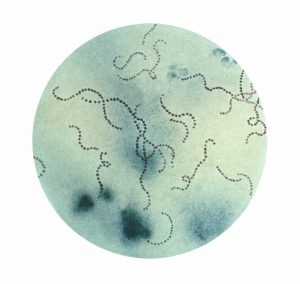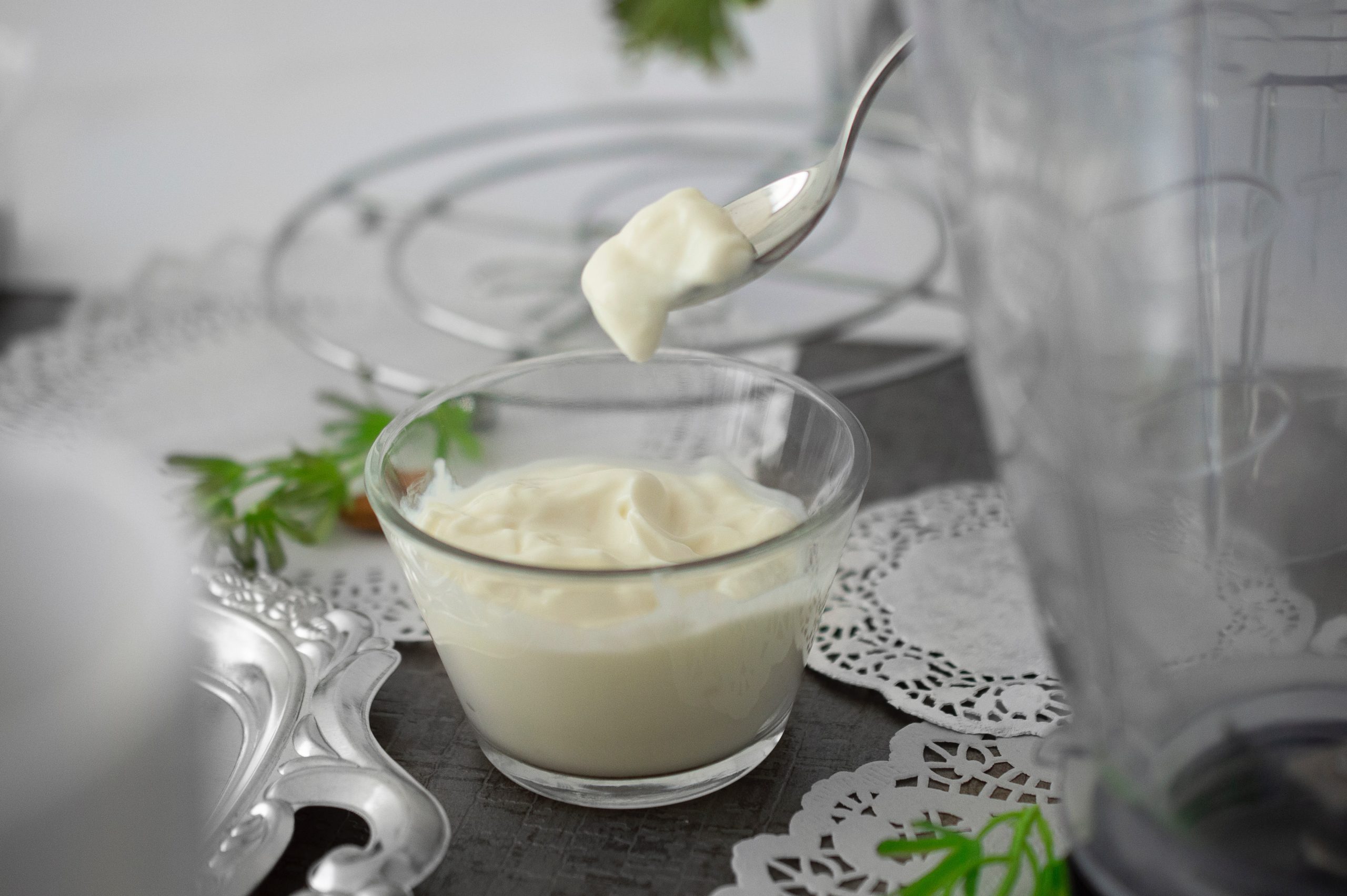13 2.6 Case Study Conclusion: Our Invisible Inhabitants
Created by CK-12/Adapted by Christine Miller

As you may recall from the beginning of the chapter, Lanying’s strep throat was caused by Streptococcus pyogenes bacteria, the species shown in the photomicrograph in Figure 2.6.1. She took antibiotics to treat the S. pyogenes infection, but this also affected her “good” bacteria, throwing off the balance of microorganisms living inside her and resulting in diarrhea and a yeast infection.
After reading this chapter, you should know that microorganisms such as bacteria and yeast that live in humans are also similar to us in many ways. They are living organisms, so we share the traits of homeostasis, organization, metabolism, growth, adaptation, response to stimuli, and reproduction. Like us, microorganisms contain genes, consist of cells, and have the ability to evolve. Lanying’s beneficial gut bacteria help digest her food as part of their metabolic processes. Lanying got a yeast infection likely because the growth and reproductive rates of the yeast living on her body were not held in check by beneficial bacteria after she took the antibiotics. You can see there are many ways in which an understanding of the basic characteristics of all life can directly apply to your own.
You also learned how living organisms are classified, from bacteria that are in the Bacteria domain, to yeast (fungus kingdom) and humans (animal kingdom) which are both in the Eukarya domain. You probably now recognize that Streptococcus pyogenes is the binomial nomenclature for this species, and the fact that Streptococcus refers to the genus name.
As Lanying’s doctor told her, there are many different species of microorganisms living in the human digestive system. You should recognize this type of biodiversity is called species diversity. This diversity is maintained in a balance, or homeostasis, that can be upset when one type of organism is killed, for instance, by antibiotics.
Lanying’s doctor advised her to complete the entire course of antibiotics because stopping too early would kill or inhibit the bacteria that are most susceptible to the antibiotic, while leaving the bacteria that are more resistant to the antibiotic alive. This difference in susceptibility to antibiotics is an example of genetic diversity. Over time, the surviving antibiotic-resistant bacteria will have increased survival and reproductive rates compared to the more susceptible bacteria, and the trait of antibiotic resistance will become more common in the population. In this way, bacteria can evolve and become better adapted to its environment — at a major cost to our health, because our antibiotics will no longer be effective! Improper use of antibiotics leading to increased antibiotic resistance is an issue of major concern to public health experts.

Lanying’s doctor suggested that she also take some probiotics — food or supplements that contain “good microorganisms.” These good bacteria help our bodies digest food and keep out “bad microorganisms.” Specifically, lactobacillus acidophilus could help combat her yeast infection and help restore normal gut function.
After reading this chapter, you know how humans are classified, and you’ve learned some characteristics of humans and other closely related species. Beyond our more obvious features of big brains, intelligence, and the ability to walk upright, we also serve as a home to many different microorganisms that may be invisible to the naked eye but play a big role in maintaining our health.
Chapter 2 Summary
In this chapter, you learned about the basic principles of biology and how humans are situated among other living organisms. Specifically, you learned:
- To be classified as a living thing, most scientists agree that an object must exhibit seven characteristics, including:
- Maintaining a more-or-less constant internal environment, which is called homeostasis.
- Having multiple levels of organization and consisting of one or more cells.
- Using energy and being capable of metabolism.
- Being able to grow and develop.
- Being capable of evolving adaptations to the environment.
- Being able to detect and respond to environmental stimuli.
- Being capable of reproducing, which is the process by which living things give rise to offspring.
- Four basic principles or theories unify all the fields of biology: cell theory, gene theory, homeostasis, and evolutionary theory.
- According to cell theory, all living things are made of cells and come from other living cells.
- Gene theory states that the characteristics of living things are controlled by genes that pass from parents to offspring.
- All living things — and even the entire biosphere — strive to maintain homeostasis.
- The characteristics of living things change over time as they evolve, and some acquire adaptations or traits that better suit them to a given environment.
- Biodiversity refers to the variety of life that exists on Earth. It includes species diversity, genetic diversity within species, and ecosystem diversity.
- The formal biological definition of “species” is a group of actually or potentially interbreeding organisms. In reality, organisms are often classified into species on the basis of morphology.
- A system for classifying living things was introduced by Linnaeus in the 1700s. It includes taxa from the species (least inclusive) to the kingdom (most inclusive). Linnaeus also introduced a system of naming species, called binomial nomenclature.
- The domain, a taxon higher than the kingdom, was later added to the Linnaean system. Living things are generally grouped into three domains: Bacteria, Archaea, and Eukarya. Humans and other animal species are placed in the Eukarya domain.
- Modern systems of classification take into account phylogenies, or evolutionary histories of related organisms, rather than just morphological similarities and differences. These relationships are often represented by phylogenetic trees or other tree-like diagrams.
- The human species, Homo sapiens, is placed in the primate order of the class of mammals, which are chordates in the animal kingdom.
- Traits that humans share with other primates include: five digits with nails and opposable thumbs; an excellent sense of vision, including stereoscopic vision and the ability to see in colour; and a large brain, high degree of intelligence, and complex behaviors. Like most other primates, we also live in social groups. Many of our primate traits are adaptations to life in the trees.
- Within the primate order, our species is placed in the hominid family, which also includes chimpanzees, gorillas, and orangutans.
- The genus Homo first evolved about 2.8 million years ago. Early Homo species were fully bipedal but had small brains. All are now extinct.
- During the last 800 thousand years, Homo sapiens evolved, with smaller faces, jaws, and front teeth, but much bigger brains than earlier Homo species.
Now you understand the basic principles of biology and some of the characteristics of living organisms. In the next chapter, you will learn about the molecules that make up living organisms, as well as the chemistry that allows organisms to exist and function.
Chapter 2 Review
- What are the four basic unifying principles of biology?
- A scientist is exploring in a remote area with many unidentified species. He finds an unknown object that does not appear to be living. What is one way he could tell whether it is a dead organism that was once alive or an inanimate object that was never living?
- Cows are dependent on bacteria living in their digestive systems to help break down cellulose in the plant material that they eat. Explain what characteristics these bacteria must have to be considered living organisms themselves (and not just part of the cow).
- What is the basic unit of structure and function in living things?
- Give one example of homeostasis that occurs in humans.
- Can a living thing exist without using energy? Why or why not?
-
-
- Give an example of a response to stimuli that occurs in a unicellular organism.
- A scientist discovers two types of similar looking insects that have not been previously identified. Answer the following questions about this discovery.
- What is one way she can try to determine whether the two types are the same species?
- If they are not the same species, what are some ways she can try to determine how closely related they are to each other?
- What is the name for a type of diagram she can create to demonstrate their evolutionary relationship to each other and to other insects?
- If she determines that the two types are different species but the same genus, create your own names for them using binomial nomenclature. You can be creative and make up the genus and species names, but be sure to put them in the format of binomial nomenclature.
- If they are the same species but have different colours, what kind of biodiversity does this most likely reflect?
- If they are the same species, but one type of insect has a better sense of smell for their limited food source than the other type, what do you think will happen over time? Assume the insects will experience natural selection.
- Amphibians, such as frogs, have a backbone, but no hair. What is the most specific taxon that they share with humans?
- What is one characteristic of extinct Homo species that was larger than that of modern humans?
- What is one characteristic of modern humans that is larger than that of extinct Homo species?
- How does the long period of dependency (of infants on adults) in primates relate to learning?
- Name one type of primate in the hominid family, other than humans.
- Why do you think that scientists compare the bones of structures (such as the feet) of extinct Homo species to ours?
- Some mammals other than primates — such as cats — also have their eyes placed in the front of their face. How do you think the vision of a cat compares to that of a mouse, where the eyes are placed more at the sides?
- Living sponges are animals. Are we in the same kingdom as sponges? Explain your answer.
Attributions
Figure 2.6.1
A photomicrograph of Streptococcus pyogenes bacteria, by Centers for Disease Control and Prevention, Public Health Image Library (PHIL) ID#2109, is in the public domain (https://en.wikipedia.org/wiki/Public_domain).
Figure 2.6.2
Yogurt, by Sara Cervera, 2019, is used under the Unsplash License (https://unsplash.com/license).
References
Wikipedia contributors. (2020, April 3). Lactobacillus acidophilus. Wikipedia. https://en.wikipedia.org/w/index.php?title=Lactobacillus_acidophilus&oldid=948947925

